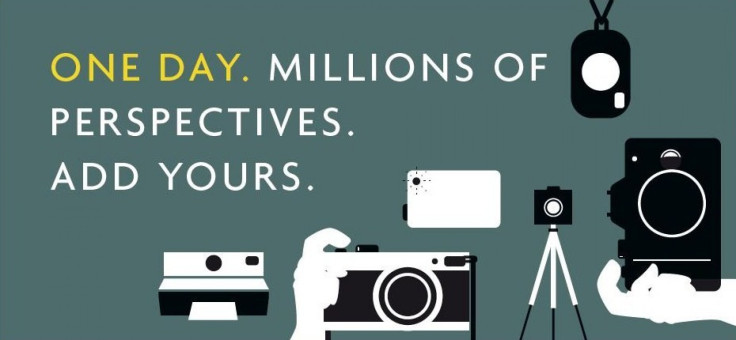ADay.org Wants Your Help To Send A Message To The Future

What will future generations know about everyday life in 2012? Swedish organization ADay.org hopes to make things easier by creating a visual archive, documenting everyday life around the world as it looked on May 15, 2012.
We want to leave a message for the future, said Jeppe Wikstrom, one of Sweden's most popular photographers and founding board member of ADay.org. This is who we were. This is what we looked like. This is what it was like.
Initiated by the non-profit foundation Expressions of Humankind and supported by a highly respected global advisory council and a special scientific council, ADay.org asks people across the globe to pick up a camera on May 15, 2012 and participate in the world's largest and most comprehensive photographic documentation of a single day in human history.
What is close to you? What matters to you, the organization asks on its website. We will connect your images to images from all around the world, creating a unique online experience where photographs will be shared, compared, and explored. Your view on life will be preserved to inspire generations to come.
Be it on a cell phone camera, Hasselblad, homemade or borrowed, ADay.org hopes everyone will join in.
We know that we have people signed up in 190 countries but it's all happening right now, Wikstrom said. We could have 10,000, 100,000, or 1 million people. We have no clue.
Participants have a week from May 15 to upload their photos and all of the images received will be displayed online in the coming month. A select few will appear in simultaneously-staged global screenings in October and physical exhibitions will open in Stockholm's Kulturhuset and Gothenburg's World Culture Museum in November before touring the globe. Also in November, a book titled A Day In The World will be published in Sweden, Finland, Norway, Spain, the UK, Australia, and the U.S. A second global edition will come out in 2013.
According to Wikstrom, the images will form the biggest searchable online picture archive of its type and a vital aid for future researchers.
A physical time capsule, constructed by Sweden's Royal Institute of Technology, will be placed in the World Heritage copper mine in Falun later this year, Wikstrom said. We will also work together with institutions around the world to ensure that these images are safe for the future.
At its heart, the organization hopes to capture and preserve the seemingly mundane aspects of everyday existence -- the things art photographers and photojournalists miss.
We'll get to see these images that we would not have seen otherwise -- those everyday moments, Wikstrom said. Who knows, it may be the images we don't pick [for the book and exhibition] that become the most important in the future.
It's a compelling thought, he added, what's happening at the same time in different places.
His words typify the growing interest in so-called time capsule art -- about how the drive to understand others often derives from a more personal need to understand ourselves.
That's certainly how the world felt back in 1955 when Edward Steichen's Family of Man debuted at the Museum of Modern Art in New York. This early attempt to document the collective human experience -- an exhibit of 508 photos by 273 photographers in 68 countries that were selected from nearly 2 million submissions -- captivated audiences around the globe as it toured nearly 40 countries. It reached more than 9 million people and was widely regarded as the most successful exhibition in the history of photography.
'Family of Man' came in the aftermath of WWII and people were drawn to the idea that humanity was one big family, Wikstrom noted. I think there remains this need for us to see each other and see things that link us together.
A precursor to ADay.org called A Day in the Life of Sweden took place in 2003. With the help of telecom giant Ericsson, the organization hopes to expand this concept to a global stage in 2012.
Technology has irrefutably changed the way we can interact and has made projects like this and the recent crowd-sourced films One Day On Earth and Life In A Day possible.
Wikstrom joked 2011 was too soon and 2013 is too late.
The organization selected May 15, a Tuesday, because it's midweek. In other words, it's ordinary. The date also brings relatively moderate temperatures for the majority of the global population and gives the organization enough time to prepare for the exhibitions and book launch before the end of the year.
Aday.org boasts a coterie of supporters armed with cameras, including several representatives at the United Nations, Archbishop Desmond Tutu, Virgin boss Richard Branson, ESA Astronaut Andre Kuipers, and Swedish superstar Robyn.
We are more aware of each other than ever before in the history of human life, Robyn said last month, announcing her participation. It's more than a perception these days, now it´s a fact that there are so many different ways to look at the world. Aday.org puts this in focus.
Branson echoed that statement saying: This great project is about real people taking pictures of real life in real-time.
Scientists will also play an important part in the project. In addition to Andrew Kuipers, who will record the day from the International Space Station, other researchers and adventurers will document everything from Antarctica to Mount Everest in hopes of capturing life at each corner of the planet.
Be it art or anthropology, science or sociology, the project is nothing if not ambitious.
Want to shape the discussion of future generations? For more information visit: http://www.aday.org/about
© Copyright IBTimes 2024. All rights reserved.






















